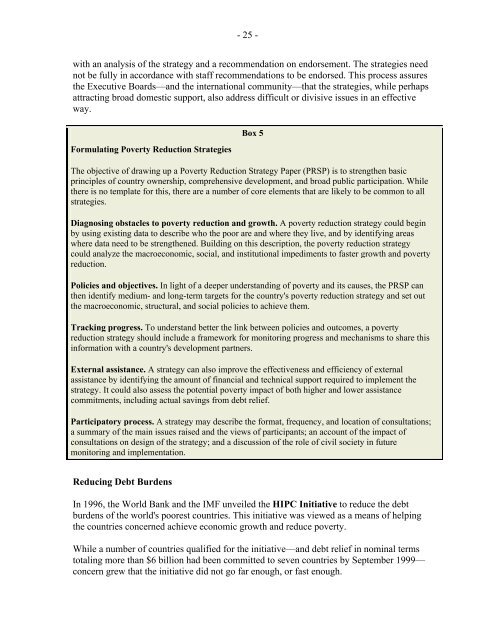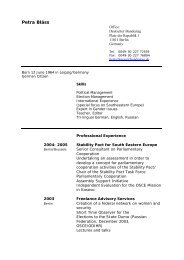What Is the International Monetary Fund? - the JVI eCampus!
What Is the International Monetary Fund? - the JVI eCampus!
What Is the International Monetary Fund? - the JVI eCampus!
Create successful ePaper yourself
Turn your PDF publications into a flip-book with our unique Google optimized e-Paper software.
- 25 -<br />
with an analysis of <strong>the</strong> strategy and a recommendation on endorsement. The strategies need<br />
not be fully in accordance with staff recommendations to be endorsed. This process assures<br />
<strong>the</strong> Executive Boards—and <strong>the</strong> international community—that <strong>the</strong> strategies, while perhaps<br />
attracting broad domestic support, also address difficult or divisive issues in an effective<br />
way.<br />
Formulating Poverty Reduction Strategies<br />
Box 5<br />
The objective of drawing up a Poverty Reduction Strategy Paper (PRSP) is to streng<strong>the</strong>n basic<br />
principles of country ownership, comprehensive development, and broad public participation. While<br />
<strong>the</strong>re is no template for this, <strong>the</strong>re are a number of core elements that are likely to be common to all<br />
strategies.<br />
Diagnosing obstacles to poverty reduction and growth. A poverty reduction strategy could begin<br />
by using existing data to describe who <strong>the</strong> poor are and where <strong>the</strong>y live, and by identifying areas<br />
where data need to be streng<strong>the</strong>ned. Building on this description, <strong>the</strong> poverty reduction strategy<br />
could analyze <strong>the</strong> macroeconomic, social, and institutional impediments to faster growth and poverty<br />
reduction.<br />
Policies and objectives. In light of a deeper understanding of poverty and its causes, <strong>the</strong> PRSP can<br />
<strong>the</strong>n identify medium- and long-term targets for <strong>the</strong> country's poverty reduction strategy and set out<br />
<strong>the</strong> macroeconomic, structural, and social policies to achieve <strong>the</strong>m.<br />
Tracking progress. To understand better <strong>the</strong> link between policies and outcomes, a poverty<br />
reduction strategy should include a framework for monitoring progress and mechanisms to share this<br />
information with a country's development partners.<br />
External assistance. A strategy can also improve <strong>the</strong> effectiveness and efficiency of external<br />
assistance by identifying <strong>the</strong> amount of financial and technical support required to implement <strong>the</strong><br />
strategy. It could also assess <strong>the</strong> potential poverty impact of both higher and lower assistance<br />
commitments, including actual savings from debt relief.<br />
Participatory process. A strategy may describe <strong>the</strong> format, frequency, and location of consultations;<br />
a summary of <strong>the</strong> main issues raised and <strong>the</strong> views of participants; an account of <strong>the</strong> impact of<br />
consultations on design of <strong>the</strong> strategy; and a discussion of <strong>the</strong> role of civil society in future<br />
monitoring and implementation.<br />
Reducing Debt Burdens<br />
In 1996, <strong>the</strong> World Bank and <strong>the</strong> IMF unveiled <strong>the</strong> HIPC Initiative to reduce <strong>the</strong> debt<br />
burdens of <strong>the</strong> world's poorest countries. This initiative was viewed as a means of helping<br />
<strong>the</strong> countries concerned achieve economic growth and reduce poverty.<br />
While a number of countries qualified for <strong>the</strong> initiative—and debt relief in nominal terms<br />
totaling more than $6 billion had been committed to seven countries by September 1999—<br />
concern grew that <strong>the</strong> initiative did not go far enough, or fast enough.



